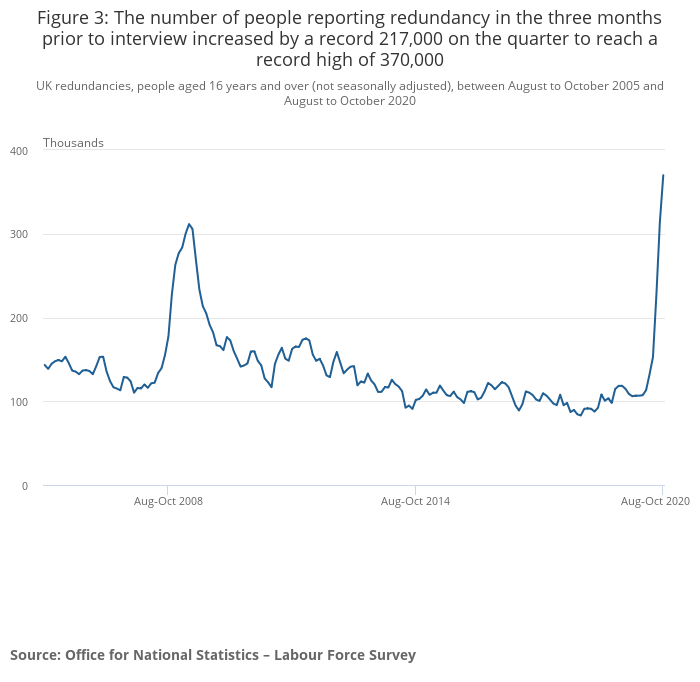UK Redundancies Reach Record Levels
Tuesday 15 December, 2020 Written by ONS (Office of National Statistics)
UK EMPLOYMENT - Early estimates for November 2020 suggest that there is a slight drop over the month in the number of payroll employees in the UK.
Since February 2020, the number of payroll employees has fallen by 819,000; however, the larger falls were seen at the start of the coronavirus (COVID-19) pandemic.
Data from the ONS Labour Force Survey (LFS) show a large increase in the unemployment rate while the employment rate continues to fall. The number of redundancies reached a record high in August to October 2020 although the weekly data show that while the level remains high there was a slight decrease in October.
Although decreasing over the year, total hours worked had a record increase from the low levels in the previous quarter, with the August to October period covering a time when a number of coronavirus (COVID-19) lockdown measures were eased. The number of people temporarily away from work has fallen since its peak in April and May 2020. The number of people away from work because of the pandemic and receiving no pay has also fallen and levelled off in recent months.
Vacancies have continued to recover in the latest period but are still below the levels seen before the impact of the coronavirus pandemic. Annual growth in employee pay continued to strengthen as more employees returned to work from furlough, but the estimated growth in average pay is also impacted by compositional effects of a fall in the number and proportion of lower-paid employee jobs.
- The UK employment rate, in the three months to October 2020, was estimated at 75.2%, 0.9 percentage points lower than a year earlier and 0.5 percentage points lower than the previous quarter.
- The UK unemployment rate, in the three months to October 2020, was estimated at 4.9%, 1.2 percentage points higher than a year earlier and 0.7 percentage points higher than the previous quarter.
- Redundancies reached a record high of 370,000 in the three months to October 2020, an increase of a record 217,000 on the quarter, although the number of redundancies fell slightly in October 2020.
- Early estimates for November 2020 indicate that the number of payrolled employees fell by 2.7% compared with November 2019, which is a fall of 781,000 employees; since February 2020, 819,000 fewer people were in payrolled employment.
- The Claimant Count increased slightly in November 2020, to 2.7 million; this includes both those working with low income or hours and those who are not working.
- There were an estimated 547,000 vacancies in the UK in September to November 2020; this is 251,000 fewer than a year ago and 110,000 more than the previous quarter.
- Growth in average total pay (including bonuses) among employees for the three months August to October 2020 increased to 2.7%, and growth in regular pay (excluding bonuses) also increased to 2.8%.

The number of people reporting redundancy in the three months prior to interview increased in August to October 2020 by a record 251,000 on the year, and a record 217,000 on the quarter, to a record high of 370,000. ONS estimates show that the number of people reporting redundancy in the three months prior to interview has been increasing since June 2020 and remains high in October but has dropped from the peak in September 2020.
According to the Business Impact of Coronavirus (COVID-19) Survey, 7% of businesses interviewed during the 19 October to 1 November 2020 period expected to make redundancies in the three months following the survey, a decrease from 9%, during the previous two weeks, 5 to 18 October 2020. The rate of expected redundancies was highest in the wholesale and retail sector (11%), and the administrative services, accommodation and food service activities, and transportation and storage sectors, all at 10%.

ABC Comment, have your say below:

1 comment
-
Comment Link
 Tuesday 15 December, 2020
posted by
Simon Collyer
Tuesday 15 December, 2020
posted by
Simon Collyer
Leave a comment
Make sure you enter all the required information, indicated by an asterisk (*). HTML code is not allowed.
Join
FREE
Here










